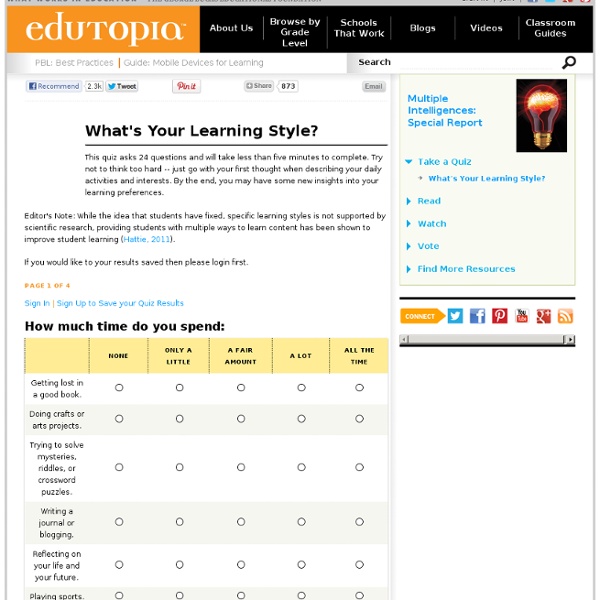8 Tips to Power-Up Your Classroom Presentations
Last month, I attended a Back to School Night for parents, sitting through presentation after presentation by teachers, some with slides that helped make their presentation a delight to listen to, and others . . . well, that's why I'm writing this blog post. The goal of a classroom presentation is to aid you in effectively conveying information in a way that allows students (or their parents) to remember what you said. Unfortunately, for some, the presentation becomes a crutch, and they begin to rely on the slides to tell their story, rather than to help them tell the story. I've been creating presentations using software like PowerPoint and KeyNote for 20 years, and I've learned a lot about how to most effectively communicate. Here's what I've found. 1.
Differentiating Instruction
Whether you teach first grade or AP Calculus, your class is certain to have a variety of learners. Perhaps you have some ESL/ELL students, some learning support, some emotional support, some gifted, and some very “average.” TeachersFirst has resources to help you understand and adapt for student differences, including general ideas for any and all students and for specific student needs. For Any and All Students: Browse examples Many TeachersFirst resource reviews include differentiation suggestions and practical ways a resource can help you meet individual needs.
Overview of learning styles
Many people recognize that each person prefers different learning styles and techniques. Learning styles group common ways that people learn. Everyone has a mix of learning styles. Some people may find that they have a dominant style of learning, with far less use of the other styles. Others may find that they use different styles in different circumstances.
Sleep learning is possible: Associations formed when asleep remained intact when awake
Is sleep learning possible? A new Weizmann Institute study appearing August 26 in Nature Neuroscience has found that if certain odors are presented after tones during sleep, people will start sniffing when they hear the tones alone -- even when no odor is present -- both during sleep and, later, when awake. In other words, people can learn new information while they sleep, and this can unconsciously modify their waking behavior.
Six Strategies for Differentiated Instruction in Project-Based Learning
Project-based learning (PBL) naturally lends itself to differentiated instruction. By design, it is student-centered, student-driven, and gives space for teachers to meet the needs of students in a variety of ways. PBL can allow for effective differentiation in assessment as well as daily management and instruction. PBL experts will tell you this, but I often hear teachers ask for real examples, specifics to help them contextualize what it "looks like" in the classroom.
Felder & Soloman: Learning Styles and Strategies
Richard M. Felder Hoechst Celanese Professor of Chemical Engineering North Carolina State University Barbara A. Soloman Coordinator of Advising, First Year College North Carolina State University
Universal Design for Learning (UDL)
Universal Design for Learning is a framework that provides educators with a structure to develop their instruction to meet the wide range of diversity among all learners. UDL is a research-based framework that suggests that a one-size-fits-all approach to curricula is not effective. UDL was inspired by universal design in architecture, where design features intended for individuals with disabilities have had unexpected benefits for the general population (e.g. curb cut outs designed for wheelchair access have benefits for strollers, rolling luggage, skateboarders, etc.) A concise definition of Universal Design for Learning was provided by the Higher Education Opportunity Act of 2008 (HEOA) The term UNIVERSAL DESIGN FOR LEARNING means a scientifically valid framework for guiding educational practice that:
Journal of Educational Controversy - Article: Developing Dispositions for Ambitious Teaching
Developing Dispositions for Ambitious Teaching David Carroll Western Washington University Critics of teacher education in recent years have argued that attempts to assess dispositions for teaching amount to a process of political indoctrination, claiming that teacher candidates are often expected to endorse ideas like “white privilege” and “social justice” as a kind of political litmus test for entering the teaching profession. In some circumstances, teacher education programs have avoided this kind of controversy by limiting their attention to dispositions such as honesty, integrity, and professional interactions.



